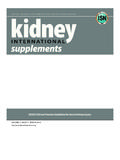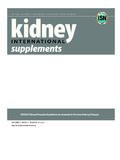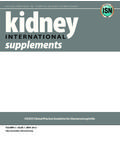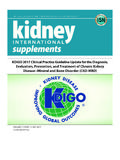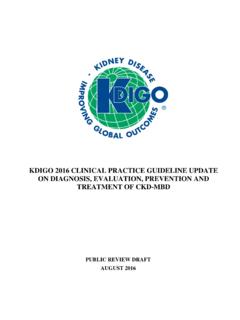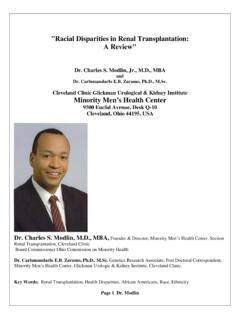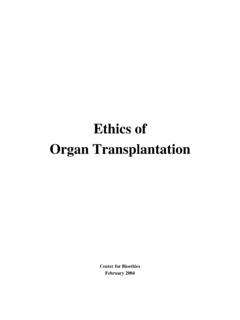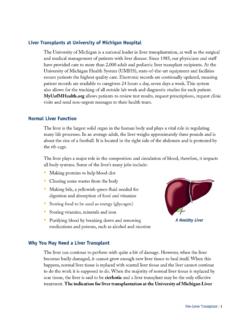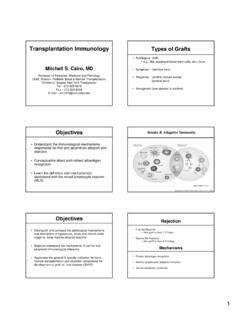Transcription of Kidney Transplantation in Korea - kdigo.org
1 Byung Ha Chunga,b, Chul Woo Yanga,bKidney Transplantation in KSN 2017 KDIGO-KSN Joint SymposiumaTransplant Research CenterbDivision of Nephrology, Department of Internal Medicine,The Catholic University of Korea , Seoul, L et al, N Eng J Med 1999; 341:1725 Long-term survival is better among those on the waiting list who eventually undergo Transplantation Yoo KD et al, Medicine 2016; 95: 33 Korean dialysis patients had significantly more cardiovascular events and higher all-cause mortality than KT patients All cause mortalityMace free survvialWhy Kidney Transplantation ??The first successful Kidney Transplantation in Korea , 1969.
2 1969 - The first living donor KT, 6 cases in this year 1979 - The first deceased donor KT at Hanyang University~ 1992 Total 4,242 cases of KT728 1891 0200400600800100012001400160018002000 Increase of Kidney Transplantation in KoreaKONOS Annual report1969 ~2015 - 29,385 cases of KTCasesIncrease of ESRD Patients in Korea01000020000300004000050000600007000 0800009000020002002200420062008201020122 01428,04687,014 Current Renal Replacement Therapy in KoreaPersonYearIncrease of patient number on waiting listPersonWaiting listWaiting time of DDKTDays1904 days (2015)Grill L et al, Kidney Int 2005; 68: 2345 Higher mortality in patients with longer waiting timeTwo strategy to increase DDKT Increase of potential donor pool Use of expanded criteria donorWorldwide deceased organ donorsInt Registry in Organ Donation and Transplantation , Dec 2014 Potential donor pool !
3 !!Donation per million person of Social ConsensusCumulative numbers of organ donation volunteer0200000400000600000800000100000 0120000014000002000200220042006200820102 0122014476541231217 Increasing number of deceased donor pool may give a more chance to ESRD patients on the wait list in et al. Am J Transplant2003; 3 (Suppl. 4): 114 125 Donor conditionAge (years) 50-59 60 CVA + HTN + Creatinine > + HTN XXCVA + Creatinine > + Creatinine > > of the aboveXVariablesAge 60 GFR 60 mL/min or serum creatinine mg/dLHypotensive episode 3 Proteinuria (++) 2 Non-heart beating donorExpanded criteria donorKONOS criteriaUNOS criteriaplant2003; 3 (Suppl.)
4 4): 114 125 More than one of aboveSuspicious of pre-existing chronic Kidney disease Survival benefits of ECD KT over DialysisOjo AO et al. J Am Soc Nephrol 2001;12:589 Comparison of allograft and patient survival between SCD and ECD groupAllograft survivalPatient survivalPark WY et al, Abstract number KSN-17-C005 509 cases of DDKT from 3 transplant centersIncrease of DDKT from ECD in KoreaMin SI et al. J Korean Med Sci 25:1122-7, 2010 Standard Criteria Donor (SCD)Expanded Criteria Donor (ECD)99901689990020040060080010001200 DDKTLDKTDDKT / (2001) -> (2015) Increase of deceased donor KTKONOS Annual reportPersonWorldwide living organ donorsInt Registry in Organ Donation and Transplantation , Dec 2014 Donation per million person is ranked as 2ndin organ donation from living donorChanging pattern of donor sourceChung BH et al KJIM 2010;:670 Seoul St.
5 Mary s Hospital 1969 2008 ; 1969 cases Increasing pattern of spousal donor Kidney transplantationWithin Living unrelated donorLiving donor subtypeIncrease of spousal donor KT20032004200520062007200820092010201120 122013201402004006008001000 Spousal donorOther living donorYearPersonsAnnual report of KONOSI ncrease of Spousal donor accounts for nearly 90 % of the increase of total living donor during the past 10 yearsComparison of the increased portion of SDKT and non-spousal LDKT20072008200920102011201220132014-100 0100200300400 SpousalNon-spousal LD%Annual report of KONOSA llograft outcome of Spousal donor KTYoon et al.
6 Nephron Clin Pract 2009; 113: c241 Lee et al. J Korean Soc Transplant 2008; 22: 232 Seoul St. Mary s HospitalSeverance HospitalClinical outcome of Spousal donor KTKorean Organ Transplantation RegistrY(KOTRY) - 2009 ~ 2012 Spousal donor LDKT (n=724) vs. Living related donor (n=2112)P= survivalPatient survivalDonor exchange program Kim BS et al. J Am Soc Nephrol 2007; 18: 1000 Huh KH et al. Transplantation 2008; 86: 430 Patients who do not have ABO or HLA compatible donors Increase of ABOic KT in KoreaKONOS Annual report 1stABO incompatible (ic) KT in Korea 2007. 2 Maryknoll Medical Center, Busan, Korea02004006008001000120020112012201320 142015 ABO icKTABO cKTProportion of ABO ickT20 % of total living donor Kidney transplantationKONOS Annual reportClinical outcome of ABO icKTKorean Organ Transplantation RegistrY(KOTRY) - 2009 ~ 2012 3043 cases of Living donor Kidney transplantationABOic KT (n=375) vs.
7 ABO cKT (n=2668)P= < in highly sensitized patients HLA antibody monitoring method Desensitization for HLA antibodySuccessful Kidney Transplantation in highly sensitized patientsAdvance of anti-HLA Ab screening methodCell-based assays Solid-phase methodsCDC(Complement-dependent)Flow-cyt ometry(Complement-independent)ELISAFlow- cytometrybeadsMultiplex platform LuminexGirnita et al. Pediatr Transplantation 2006 Better sensitivity and specificity for the prediction of ABMR !! Luminex Single Antigen Bead Reproducibility Rapid evaluation Quantitative assay High Sensitivity Luminex beadAlloantibody in serumPE- anti-IgG Detection of anti-HLA antibody at Single Antigen level Match with Donor HLA typing Determine Donor SpecificityHLA Single AntigenPrediction of ABMRS trong BH et al.
8 Transpl Int 2013Oh EJ et al, Ann Lab Med 2015;35:321 Analysis of SAB performed in five laboratoriesusing identical protocol and reagents resulted in high levels of concordance and strong correlationComplement binding assay33 IgG-SABC1q-SABC omplement-fixing capability of HLA antibodiescan be determined using C1q or C3d solid phase assaysDesensitization StrategyPP/ IVIGS plenectomyRituximabPre B cells& B cellsPlasma cellsClonalexpansionB-cell targeting therapies RituximabEculizumabBortezomibDesensitiza tion for LDKTP rotocols in most centers are based on RTX/PP/low dose IVIg in KoreaSeverance HospitalSeoul National University HospitalAsan Medical Center
9 Seoul St. Mary s HospitalClinical outcomes of Highly Sensitized Patients in KoreaHuh KH et al. Int Urol Nephrol 2012;44:1549 86 highly sensitized patients from six transplant center in Korea Between 2002 and 20103 year allograft survival rate ; %20 %Sensitization rate in patients in waiting listPark et al. Transplant Proc 2016; 48: 246485%15%XM (-)XM (+) % shows strong sensitizationOut of 3145 ESRD patients on waiting listProtocol for DDKT based on High dose IVIgJeong JC et al, Medicine 2016; 95: 5 2 doses of High dose IVIg (2g / kg) Single dose of rituximab (375 mg/m2) 4 doses of bortezomib ( mg/m2)Desensitization decreased MFI of class I PRAS uccess rate of DDKT higher in study group ( % vs.)
10 %)Advancement of immune suppression Prograf 1998 , Advagraf 2010 Cipol-N 1997 Neoral 1984 Myrept 2009 Tacrobell 2005 Cellcept 1997 Myfortic 2003 (1984)OKT3 Tacrolimus (1998)MMF (1997)ThymoglobulinBasiliximabSirolimusE C-MMFC ostimulation blockade ???Azathioprine EraCalcineurin inhibitors EraDrug MinimizationImmune Suppression pattern2%13%85%NOATGB asiliximabChang JY et al, PLoS One on revision636 KTRs from 9 transplant centerTacrolimus based triple therapy with basiliximab inductionImprovement allograft survivalKim et al. J Korean Soc Transplant 2001; 15: 8 Kwon et al. Transplant Proc 2005; 37.
